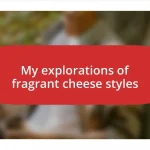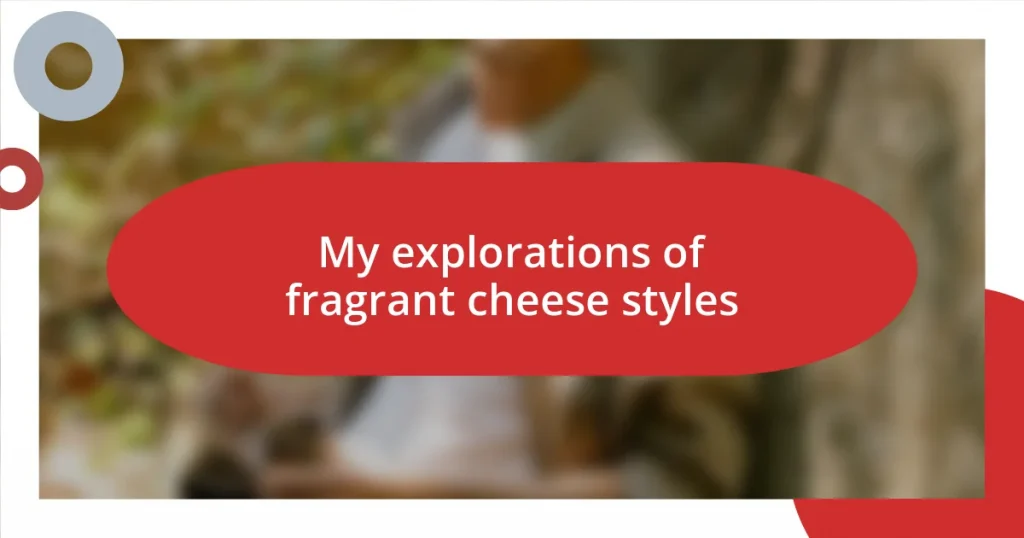Key takeaways:
- Fragrant cheeses, such as washed-rind and blue cheeses, offer unique aromas and flavors that enhance culinary experiences and evoke personal memories.
- Pairing fragrant cheeses with contrasting flavors, like fruits and breads, can significantly elevate the tasting experience and lead to memorable moments.
- Proper storage techniques, including wrapping and temperature management, are crucial for maintaining the character and quality of fragrant cheeses.
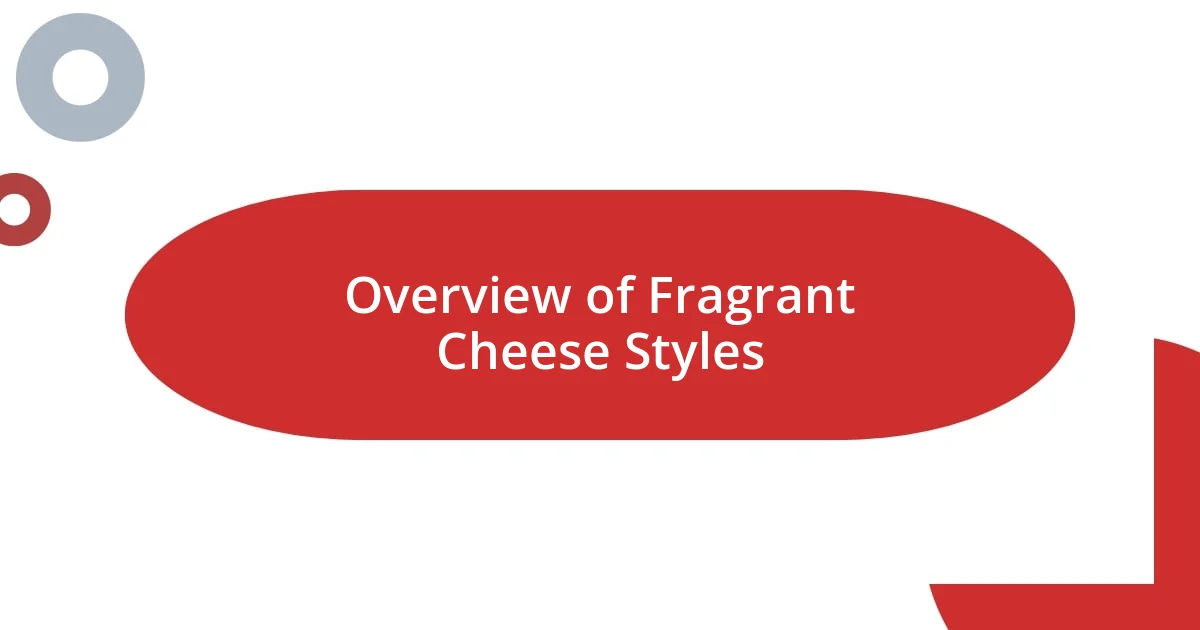
Overview of Fragrant Cheese Styles
Fragrant cheese styles are a delightful world unto themselves, often characterized by their strong aromas and robust flavors. Varieties like washed-rind cheeses, for instance, evoke childhood memories of visits to local dairies, where the tangy scent filled the air and excited my senses. Have you ever tasted a cheese that transported you to a place based on its smell alone? That’s the magic of these cheeses.
When I think of fragrant cheeses, I often reflect on how they can transform a simple meal into something extraordinary. Cheeses such as Epoisses or Limburger possess a pungency that can be polarizing, yet, for me, they are a source of joy and bold experiences. Have you ever hesitated to try a cheese that looked or smelled intimidating? I sure have, but giving those cheeses a chance has led to some of my most memorable culinary adventures.
The diversity within fragrant cheese styles is truly astounding. From nutty and creamy to earthy and gamey, each variety tells a story of its region and production methods. I remember the first time I tried a stinky cheese paired with a crisp wine—it was an explosion of flavors that made the experience unforgettable. What’s your favorite way to enjoy fragrant cheese? It’s always fascinating to discover different pairings.
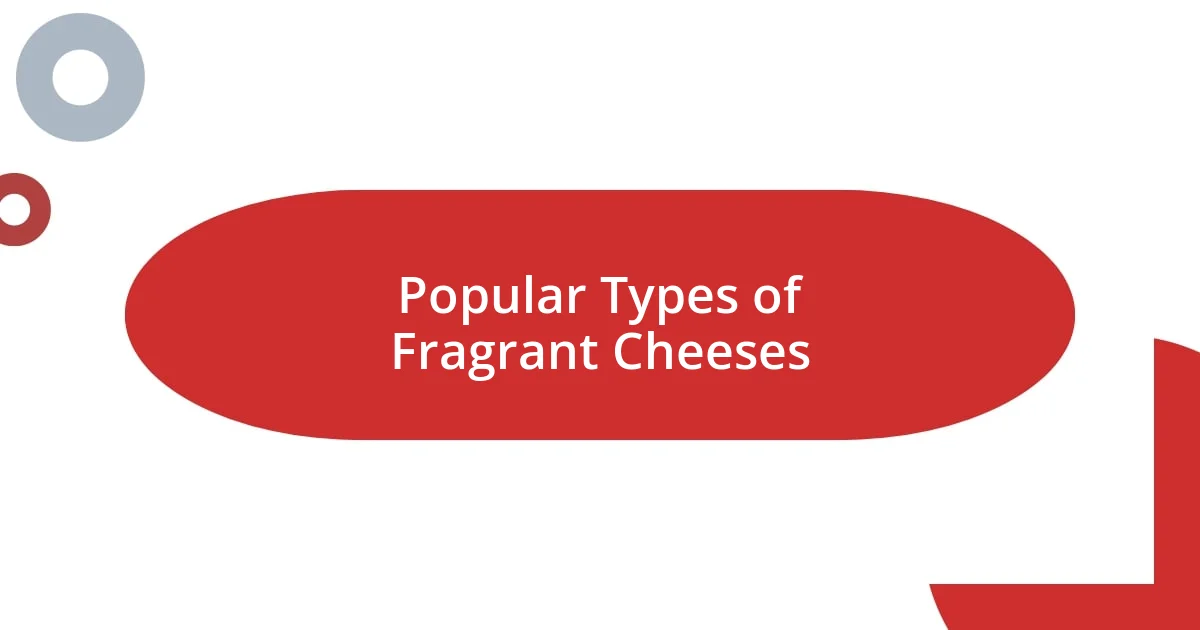
Popular Types of Fragrant Cheeses
Washed-rind cheeses are among my favorites when it comes to fragrant varieties. Their unique processing method—where they’re regularly washed with brine or alcohol—cultivates a smell that can be quite intense. I remember indulging in a piece of Taleggio after a long day; the aroma was robust yet inviting, making the experience feel like a warm hug. Have you ever encountered a cheese that seemed overwhelming but turned out to be surprisingly delightful?
Another popular type is blue cheese, distinguished by the blue-green veins created by mold. I still recall the first bite of Roquefort; its sharpness was balanced by a creamy texture that sent my taste buds into overdrive. It’s intriguing how different blue cheeses can have such varied flavor profiles. Have you ever paired blue cheese with honey? That sweet-cheesy contrast is a game-changer.
Finally, let’s not overlook the creamy, strong-smelling American varieties like Limburger, known for its challenging aroma that often prompts strong reactions. I was a bit anxious the first time I tried it, but once I combined it with crusty bread and some pickles, it transformed into an entirely different flavor experience—one that unlocked layers of taste I hadn’t anticipated. Isn’t it fascinating how the right pairing can change your perception of a cheese altogether?
| Cheese Type | Aroma/Flavor Profile |
|---|---|
| Washed-Rind Cheeses | Robust, tangy, often salty |
| Blue Cheeses | Sharp, creamy, with a hint of earthiness |
| Limburger | Strong, pungent, and sometimes described as “barnyard” in aroma |

Key Characteristics of Fragrant Cheeses
When I think about fragrant cheeses, the presence of robust aromas and distinct textures often stands out. Each type seems to carry its own unique signature, transforming experiences into flavorful journeys. For instance, my first encounter with a pungent Camembert had me simultaneously intrigued and hesitant; the scent enveloped me like a warm blanket but also left me questioning if I could handle it. That moment taught me the importance of looking beyond my initial reactions.
- Aroma Intensity: Fragrant cheeses typically have strong, often complex aromas that can evoke various emotions or memories.
- Texture Variation: These cheeses can range from creamy to crumbly, enhancing the sensory experience.
- Flavor Complexity: The flavors tend to be bold, with some offering sweet notes while others present earthy undertones.
- Cultural Ties: Many fragrant cheeses are closely tied to their regions of origin, reflecting local traditions and environments.
- Aging Factors: The aging process can significantly influence both aroma and taste, making each cheese unique.
I remember a tasting event where a lovely Brie, soft and inviting, surprised me with a robust flavor that lingered on my palate. It was a memorable reminder that not all cheeses need to be pungent to leave a lasting impression. Sometimes, it’s the unexpected combinations, like indulging in a drizzle of truffle oil atop a delicate cheese, that truly elevate the experience. Engaging with these nuances makes me more appreciative of the art behind cheese-making and how every fragrant bite unveils a new layer of stories.
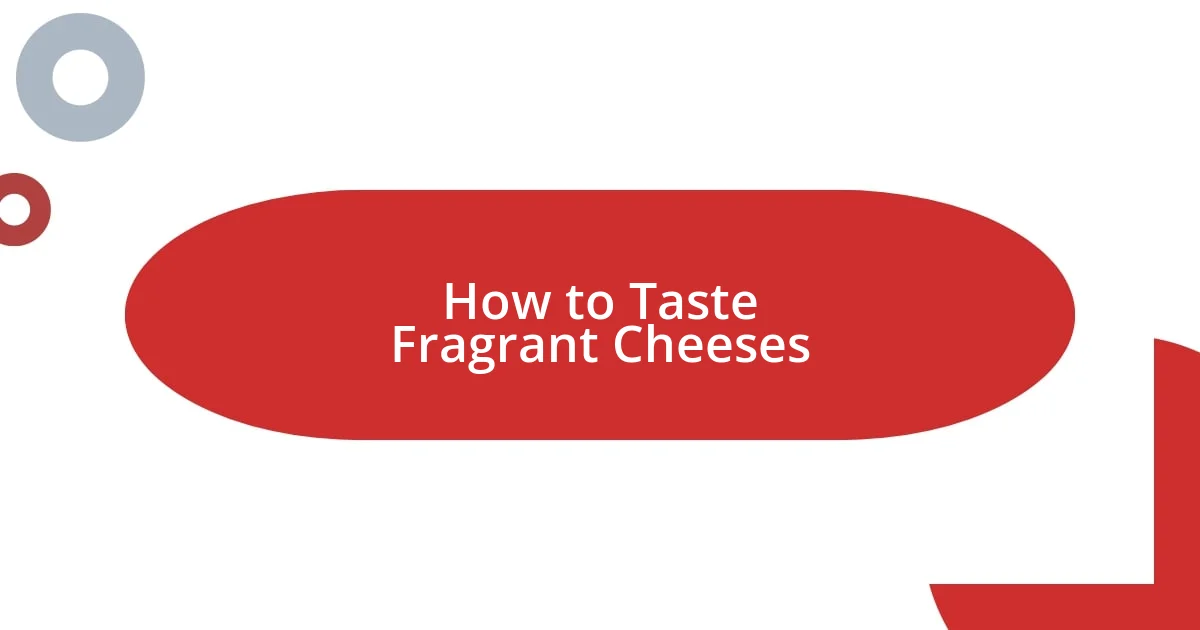
How to Taste Fragrant Cheeses
To truly appreciate fragrant cheeses, I find that starting with the visual aspect is essential. Take a moment to observe the cheese’s appearance—its colors, textures, and even the slight sheen can give clues about what to expect. I recall a vibrant piece of Epoisses that caught my eye immediately, its orange rind promising bold flavors. Have you ever noticed how the visual appeal can elevate anticipation before tasting?
Once you dive in, don’t rush the experience. Allowing the cheese to roam on your palate is vital. When I first tasted a pungent Roquefort, I closed my eyes and let it melt slowly, savoring the complex interplay of salty and creamy notes. How often do we savor moments in our busy lives? Taking that time makes all the difference, unveiling flavors that might go unnoticed otherwise.
Finally, pairing fragrant cheeses with complementary elements can enhance the tasting journey even more. I remember sampling a washed-rind cheese with a sweet fig jam; the combination was nothing short of divine. Have you ever discovered that one pairing that completely transformed your cheese experience? Engaging with such flavors makes me reflect on how personal journeys through cheese lead to memorable moments that expand our gastronomic horizons.
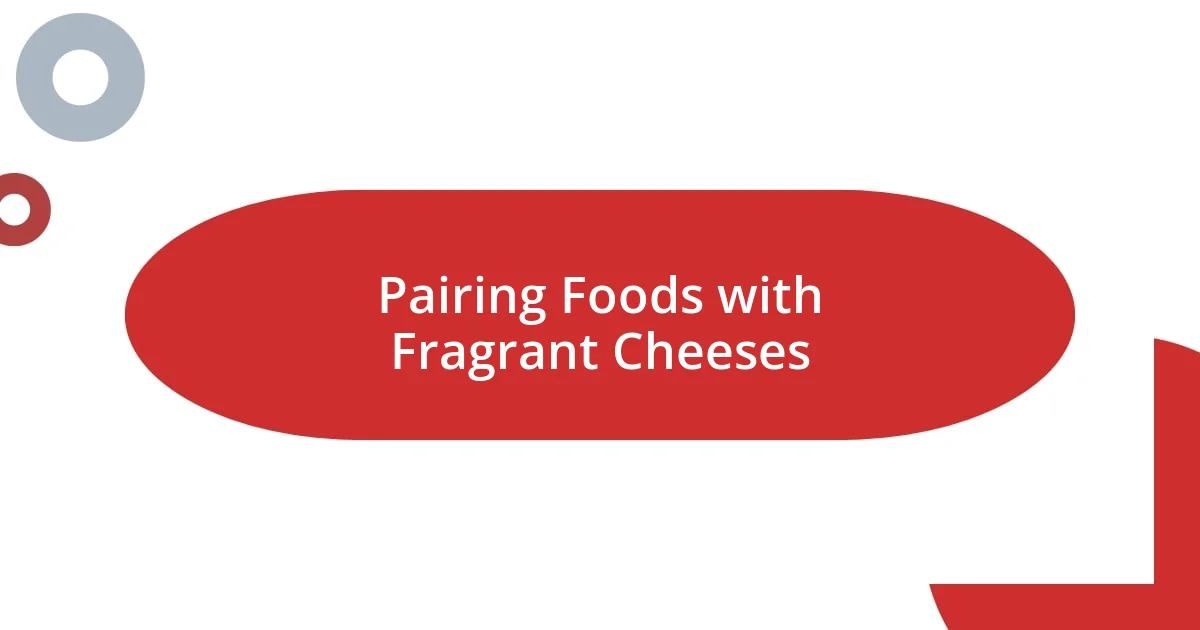
Pairing Foods with Fragrant Cheeses
When it comes to pairing foods with fragrant cheeses, I love to experiment with contrasting flavors. For example, I once paired a bold Roquefort with a crunchy apple salad. The tartness of the apples beautifully cut through the cheese’s intense saltiness. Have you ever tried a combination that shocked you with its perfection? It’s all about finding that balance that makes your taste buds dance.
In my experience, having some fresh bread nearby is a game changer. I remember enjoying a creamy Brie on a warm baguette, topped with a sweet peach chutney. The buttery texture of the cheese melded perfectly with the bread, while the chutney added a refreshing sweetness. It’s moments like these that remind me of the joy of simple, yet elegant, pairings.
For those adventurous souls looking to take it up a notch, I recommend incorporating nuts or charcuterie into your spread. I once hosted a gathering where my guests raved about a fragrant Limburger paired with roasted hazelnuts and prosciutto. The flavors intertwined, creating a symphony on the palate. Do you have a favorite cheese pairing that sparks joy? It’s in these delightful combinations where memories are created and shared.

Storage Tips for Fragrant Cheeses
When it comes to storing fragrant cheeses, I can’t stress enough the importance of keeping them in the right environment. I remember a time when I carelessly left a pungent cheese uncovered in my fridge, only to find it spreading its aroma throughout every corner. It’s essential to wrap your cheese in parchment paper or wax paper, as these materials allow the cheese to breathe without becoming too dry. Have you ever had that moment of pulling a cheese out only to find it’s lost its character?
Temperature plays a crucial role as well. I always aim to store my fragrant cheeses in the warmest part of the fridge, ideally around 40-45°F (4-7°C). In one memorable instance, I left a beautifully aromatic taleggio on the top shelf. I was shocked at how the mellow flavors deepened over a few days, showcasing an even richer profile when enjoyed later. Wouldn’t you agree that a slight elevation in temperature can unleash more of a cheese’s intriguing complexities?
Lastly, I suggest labeling your cheese containers with the date they were opened. It’s an incredibly handy tip I picked up during a cheese-tasting workshop. I once forgot how long a particularly fragrant Roquefort had been sitting around, and it turned out to be my loss—what an unpleasant surprise! Keeping track of freshness not only enhances the flavors but also ensures that you experience each cheese at its best. How do you manage your cheese inventory? It’s those little details that can elevate your cheese experience significantly.
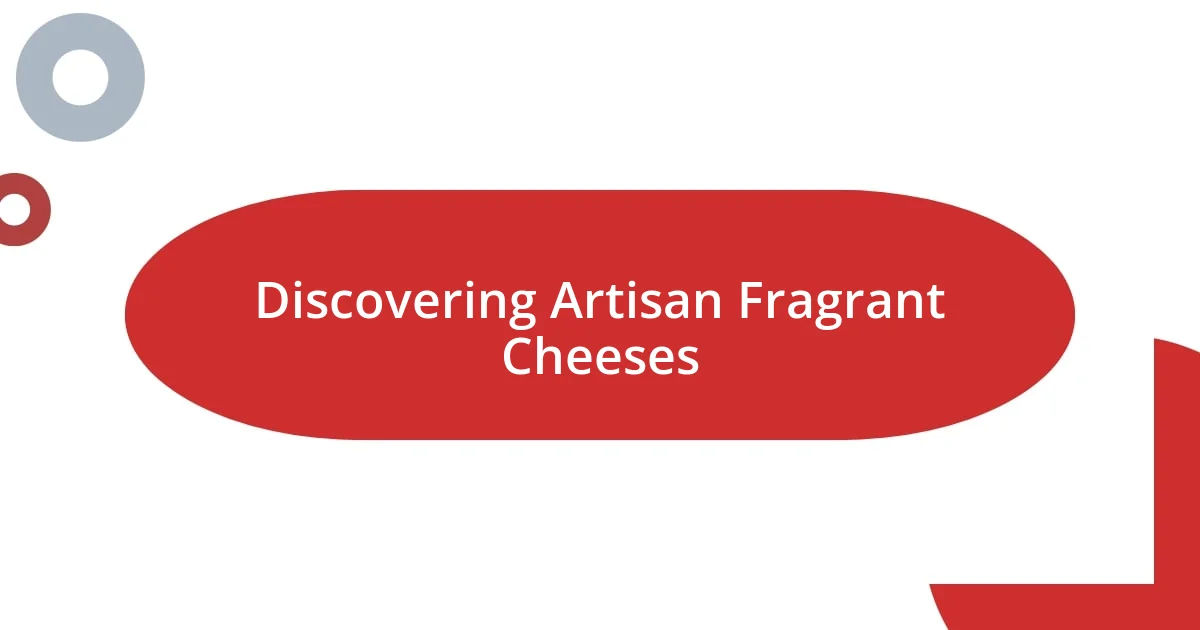
Discovering Artisan Fragrant Cheeses
When I first ventured into the world of artisan fragrant cheeses, I was completely captivated by the diverse styles and aroma profiles. I vividly remember coming across an herbal cheese infused with rosemary and garlic. The moment I took a bite, the flavors exploded in my mouth, revitalizing my senses. Have you ever stumbled upon a cheese that was nothing short of a revelation? That experience sparked my passion for finding unique, fragrant cheeses that tell a story.
Each artisan cheese I discover has a unique background that deepens my appreciation. For instance, I once learned about a small farm in France crafting a lovely chevre that was delicately blended with lavender. Attending a tasting event, I savored its floral notes, which transported me to sun-drenched fields in Provence. It made me realize how much the environment, from the grass to the air, influences a cheese’s character. Isn’t it fascinating how flavors can evoke such vivid imagery?
Exploring artisan cheeses also opens the door to incredible pairings. One evening, I hosted a cozy gathering featuring an aged Gouda with hints of caramelized sugar. I paired it with a spicy fig jam, creating a sweet-and-savory explosion in every bite. My friends couldn’t believe how well those flavors intertwined, leading us to share our favorite cheese experiences late into the night. What’s been your most memorable cheese moment? It’s these flavorful explorations that not only tantalize the taste buds but also create lasting connections with those we share them with.



